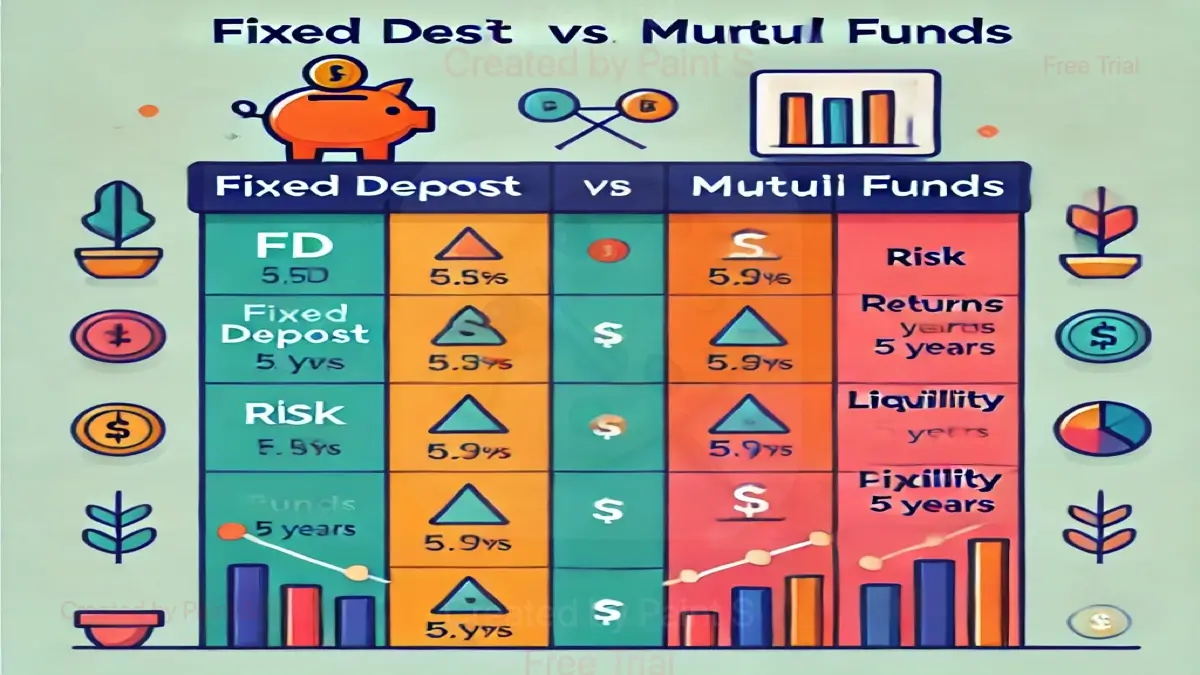When investing money, people often get confused between Fixed Deposits (FDs) and Mutual Funds. Both have their own advantages and risks, but if the goal is to build a bigger corpus, choosing the right option is important.
In this article, we will compare FD and mutual funds in simple words and with detailed examples so that you can make an informed decision.
Fixed Deposit (FD)
A Fixed Deposit (FD) is a safe investment option provided by banks and financial institutions. You deposit a fixed amount for a fixed period, and the bank gives you interest. The interest rate is fixed and does not change during the investment period.
Features of FD:
✔ Safe and low-risk investment
✔ Fixed interest rate
✔ Guaranteed returns
✔ No effect of market fluctuations
✔ Premature withdrawal possible (with penalty)
Example of FD Investment (₹5 Lakh)
Let’s assume you invest ₹5,00,000 in an FD for 5 years at an interest rate of 7% per annum (compounded quarterly).
Using the FD formula: A = P \times (1 + r/n)^{nt}, Where
- A = Final Amount
- P = Principal (₹5,00,000)
- r = Annual Interest Rate (7% or 0.07)
- n = Number of times interest is compounded in a year (4 for quarterly)
- t = Number of years (5)
After calculation, the maturity amount will be around ₹7,05,000.
So, your profit is ₹2,05,000 in 5 years.
Understanding Mutual Funds
A Mutual Fund is a market-linked investment where money is pooled from different investors and invested in stocks, bonds, or other assets. The returns depend on market performance.
Types of Mutual Funds:
- Equity Mutual Funds – High risk, high returns
- Debt Mutual Funds – Low risk, lower returns
- Hybrid Funds – Medium risk, balanced returns
Features of Mutual Funds:
✔ Higher return potential than FD
✔ Returns are not fixed but depend on market performance
✔ Risk varies based on the type of mutual fund
✔ Liquidity – Can be redeemed anytime
✔ No fixed interest, but historical data can help estimate returns
Example of Mutual Fund Investment (₹5 Lakh)
Now, let’s assume you invest ₹5,00,000 in an Equity Mutual Fund for 5 years, which gives an average annual return of 12% per annum (historical average).
Using the Compound Interest formula:
A = P \times (1 + r/n)^{nt}, Where:
- P = ₹5,00,000
- r = 12% (0.12)
- n = 1 (compounded annually)
- t = 5 years
After calculation, the maturity amount will be around ₹8,81,000.
So, your profit is ₹3,81,000 in 5 years.
Comparing FD vs Mutual Funds
| Factor | Fixed Deposit (FD) | Mutual Fund (Equity) |
|---|---|---|
| Risk | Very Low | Medium to High |
| Returns | Fixed (7% per annum) | Market-linked (10-15% per annum) |
| Profit in 5 Years | ₹2,05,000 | ₹3,81,000 |
| Liquidity | Can withdraw with penalty | Can redeem anytime |
| Taxation | Interest taxable | Capital gains tax (based on duration) |
| Best For | Safe investors | Investors looking for high returns |
Which Builds a Bigger Corpus?
From the above examples, it is clear that mutual funds generate a bigger corpus than FD in the long term. FD is safe but offers lower returns, whereas mutual funds have higher returns but come with risks.
Who Should Invest in FD?
✔ Investors who want guaranteed returns
✔ Retired individuals looking for safe income
✔ People who do not want risk
Who Should Invest in Mutual Funds?
✔ Investors looking for higher returns
✔ People who can invest for 5-10 years
✔ Those who understand market risks
Conclusion:
If you are investing ₹5 lakh and want to maximize your corpus, then mutual funds are a better option than FD in the long run. However, if your main concern is safety, then FD is a good choice.
A smart approach is to diversify your investment – put some money in FD for safety and some in mutual funds for growth. This way, you balance risk and returns.
Would you choose FD or mutual funds for your ₹5 lakh investment? Let us know in the comments! 🚀






